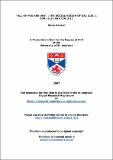Files in this item
"All of you are one" : the social vision of Gal 3:28, 1 Cor 12:13 and Col 3:11
Item metadata
| dc.contributor.advisor | Bauckham, Richard | |
| dc.contributor.advisor | Green, Joel B. | |
| dc.contributor.author | Hansen, Bruce | |
| dc.coverage.spatial | 288 | en |
| dc.date.accessioned | 2008-03-04T12:48:31Z | |
| dc.date.available | 2008-03-04T12:48:31Z | |
| dc.date.issued | 2007-11-30 | |
| dc.identifier | uk.bl.ethos.552051 | |
| dc.identifier.uri | https://hdl.handle.net/10023/433 | |
| dc.description.abstract | Paul's citation of an early baptismal tradition in Gal 3:28, 1 Cor 12:13 and Col 3:11 is as notable for its prominence in the Pauline corpus as it is for its ambiguity. A survey of the variety of views as to what Paul is denying and, conversely, affirming by this formula highlights the importance of identifying both the broad mythic vision into which Paul has set it as well as the social arrangements he advocates by means of it. This attention to how cultural symbols and stories correlate with social praxis is prompted by insights from the sociology of knowledge. This thesis argues that in each instance Paul deploys the formula to support his vision for social unity in his churches that are composed of members from various social strata and subcultures who in Christ gain a new social identity that they are to express as family-like solidarity. The predominance of kinship terminology and expectations in Paul's exhortations to ecclesial unity lead me to propose a model of ethnic identity construction as appropriate for assessing the role of the baptismal unity formula in its Pauline usage. A reading of each epistle in which the formula occurs demonstrates how the formula serves in each case to epitomize Paul's vision for social unity. Furthermore, the proposed model of ethnic identity formation serves to highlight how Paul warrants that social solidarity by appeal to the believers' fictive, genealogical connectedness and presumed shared origins and essence. Such contextualization of the formula within the social vision expressed in each epistle highlights how Paul patterns the believers' identity on Israel as reconfigured through the story of Christ Jesus' death and resurrection. This assessment of Pauline social identity formation depends on and contributes to apocalyptic understandings of Paul's gospel as well as the social emphasis of the so-called new perspective on Paul. | en |
| dc.format.extent | 2859424 bytes | |
| dc.format.mimetype | application/pdf | |
| dc.language.iso | en | en |
| dc.publisher | University of St Andrews | |
| dc.rights | Creative Commons Attribution-NonCommercial-NoDerivs 3.0 Unported | |
| dc.rights.uri | http://creativecommons.org/licenses/by-nc-nd/3.0/ | |
| dc.subject | Paul, the Apostle, Saint | en |
| dc.subject | Bible, N.T., Epistles of Paul | en |
| dc.subject | Community, Religious aspects | en |
| dc.subject | Ethnicity | en |
| dc.subject.lcc | BS2650.52H2 | |
| dc.subject.lcsh | Paul, the Apostle, Saint | en |
| dc.subject.lcsh | Bible. N.T. Epistles of Paul--Criticism, interpretation, etc | en |
| dc.subject.lcsh | Communities--Religious aspects--Christianity | en |
| dc.subject.lcsh | Ethnicity--Religious aspects--Christianity | en |
| dc.title | "All of you are one" : the social vision of Gal 3:28, 1 Cor 12:13 and Col 3:11 | en |
| dc.type | Thesis | en |
| dc.type.qualificationlevel | Doctoral | en |
| dc.type.qualificationname | PhD Doctor of Philosophy | en |
| dc.publisher.institution | The University of St Andrews | en |
This item appears in the following Collection(s)
Except where otherwise noted within the work, this item's licence for re-use is described as Creative Commons Attribution-NonCommercial-NoDerivs 3.0 Unported
Items in the St Andrews Research Repository are protected by copyright, with all rights reserved, unless otherwise indicated.


